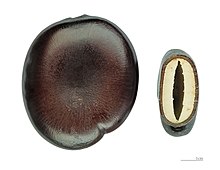Hydrochory
Hydrochory is the spread of plant diaspores by means of water (swimmers).
The spreading can take place very efficiently, as enormous distances can be covered with the help of flowing waters or large bodies of water. The plants are mostly themselves aquatic plants (floating plants) or settle near the water. But especially in the group of ombrochore plants, which use the rainwater as an aid to spreading, areas that are not influenced by water, including deserts, are colonized. There are three major groups:
-
Nautochorie or Nautohydrochorie , distribution of special buoyant diasporas or entire floating plants by water currents
- Limnochory , is the swimming spread in fresh water
- Thalasochory or halochory , is the spread of swimming in salt water (sea)
A distinction can then be made between underwater and overwater transport.
- Bythisochory or rheochory also reohydrochory, the spread of diaspores of land plants that are not adapted to swimming, due to the flow of rivers
-
Ombrochory , the spread by raindrops with the fine division into
- Regenschwemmlinge (Ombrohydrochorie)
- Regenballisten (hydro ballochorie ) (Ball ombrochorie )
- Another special form is cryochoria or cryohydrochory , the spread of diaspores trapped in ice and glaciers
Nautochory
The nautochory is used by aquatic and marsh plants or plants that colonize near water. The diaspores of these plants are often very resistant and can germinate for up to 15 years. It can be further divided into lightweight swimmers and air cave swimmers . A well-known representative of this unit of distribution is the coconut ( Cocos nucifera ). The drupe is prepared by their structure for long journeys and can pass of germination of South India to South America. The mesocarp serves as a shock absorber and the air-filled exocarp as an ion barrier (salt water). The spread of floating algae such as seaweed through ocean currents is also included.
Bythisochory or rheochory
The bythisochory or rheochory is the spread of diaspores of land plants that are not adapted to swimming with the help of water currents. It occurs through streams and rivers or temporary bodies of water such as floods or rivulets as a result of heavy rain. The mud that settles after floods is usually very rich in diaspores. Many species can thus spread over great distances along river banks. A short transport in fresh water does not harm most seeds, but if they get into permanent water they usually perish. The diaspores are often bubble-shaped as in the yellow pond rose ( Nuphar lutea ) or contain a floating tissue (low specific density) as in the marsh marigold ( Caltha palustris ).
See also
Web links
- Wayne P. Armstrong: Drift Seeds and Drift Fruits. Seeds That Ride The Ocean Currents. In: Wayne's Word. Retrieved on July 12, 2020 (English, a description of the spreading paths of various diaspores across the oceans).
Individual evidence
- ↑ a b F. G. Schroeder: Textbook of plant geography. Quelle & Meyer, 1998, ISBN 3-494-02235-6 , p. 32 f, online at yumpu.com, accessed on September 2, 2017.
- ↑ Ecology. Vol. XIV, Brooklyn Botanic Garden, 1933, p. 226, archive.org .
- ↑ Preslia. 43, 1971, p. 77.
- ↑ CF Esteves et al .: On the Limited Potential of Azorean Fleshy Fruits for Oceanic Dispersal. In: PLOS ONE . 10 (10), 2015, e0138882, doi: 10.1371 / journal.pone.0138882 .
- ^ L. van der Pijl : Principles of Dispersal in Higher Plants. Second Edition, Springer, 1972, ISBN 3-642-96110-X , pp. 60-65.
- ^ Fausto O. Sarmiento: Diccionario de ecología. Ediciones Abya Yala, 2000, ISBN 9978-04-677-1 , p. 61.
